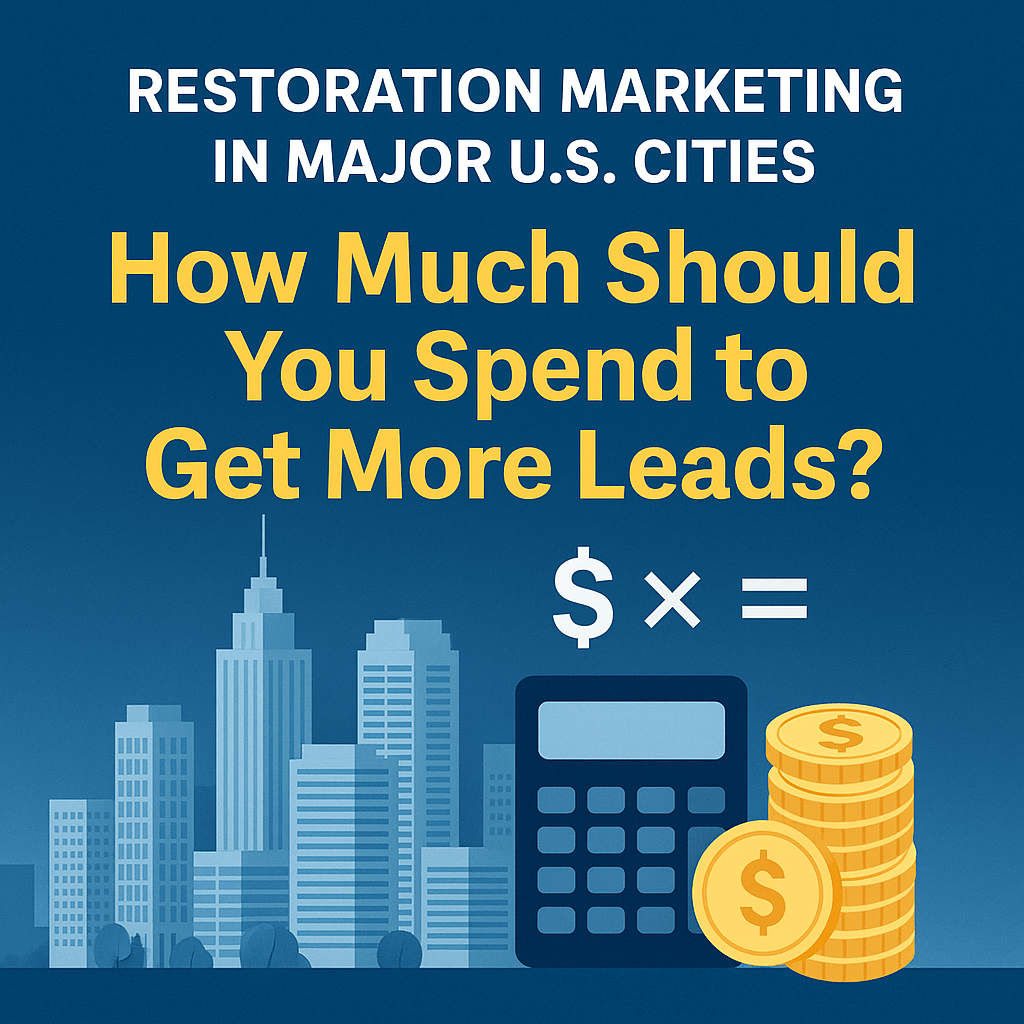If you’re running a restoration company in a major metropolitan area like Los Angeles, New York City, Chicago, or Houston, you already know the challenges of standing out in a competitive market. With numerous restoration businesses vying for the same emergency calls, having a strategic digital marketing approach isn’t just helpful—it’s essential for survival and growth.
But the question that keeps many restoration business owners up at night remains: “How much should I actually be spending on digital marketing to see real results?”
In this comprehensive guide from Thomas Town Digital, we’ll break down realistic restoration marketing budgets for major metro areas, provide data-driven forecasts for lead generation, and show you exactly what return on investment (ROI) you can expect at different spending levels.
The Realities of Restoration Marketing in Competitive Markets
Before diving into specific numbers, let’s address an important truth about digital marketing for restoration companies in major metropolitan areas: effective marketing in these regions requires significant investment.
Unlike smaller markets where you might generate meaningful lead flow with a modest budget, high-competition areas like Miami, Los Angeles, or New York demand more substantial marketing spend to achieve visibility and consistent lead generation.
Why? Because in these markets:
- More restoration companies are bidding on the same keywords
- Cost-per-click rates are substantially higher
- Consumers have more service provider options
- Local service areas often overlap with multiple competitors
Restoration Marketing Budget Benchmarks for Major Metro Areas
Based on our analysis of successful restoration companies across the United States, we’ve identified a critical threshold for effective digital marketing in competitive metropolitan markets:
Minimum recommended monthly digital marketing budget: $15,000
This figure represents the baseline investment needed to generate consistent, scalable lead flow in high-competition areas. While you can certainly spend less, companies operating below this threshold typically struggle to achieve the visibility and lead volume needed for meaningful growth.
Here’s how a $15,000 monthly restoration marketing budget might be allocated across channels:
- Google Local Services Ads (LSAs): $4,500 (30%)
- Google Search Ads (PPC): $6,000 (40%)
- Retargeting & Display: $1,500 (10%)
- SEO & Content: $2,250 (15%)
- Social Media: $750 (5%)
Cost Per Lead Breakdown by Channel
Understanding your cost per lead (CPL) is crucial for budgeting and forecasting. Here are the nationwide averages for high-performing restoration campaigns in competitive markets:
| Service & Channel | Average Cost Per Lead |
|---|---|
| Water Damage (Local Services Ads) | ~$200 |
| Water Damage (PPC) | $500+ |
| Mold Remediation (PPC) | ~$100 |
| Competitor Brand Campaigns (PPC) | ~$200 |
Important note: These figures can fluctuate based on seasonality, geographic market specifics, and sudden increases in demand (like following major storms or flooding events).
Lead Volume Forecast by Budget Tier
Using a blended cost per lead of approximately $300 across all digital channels and factoring in a 50% lead qualification rate (meaning half of your incoming leads will be qualified business opportunities), here’s what you can expect at different budget levels:
$15,000/month investment:
- Total leads generated: ~50
- Qualified leads: ~25
- Potential new jobs: ~15-20
$20,000/month investment:
- Total leads generated: ~67
- Qualified leads: ~33
- Potential new jobs: ~20-25
$25,000/month investment:
- Total leads generated: ~83
- Qualified leads: ~41
- Potential new jobs: ~25-30
ROI Breakdown: What Returns Can You Expect?
Now for the most important question: “Is this investment worth it?”
Let’s calculate the potential return using conservative estimates:
- Average revenue per restoration job: $10,500
- Average jobs from 25 qualified leads (at $15K/month spend): 15
- Monthly revenue potential: $157,500
- Monthly marketing investment: $15,000
- ROI ratio: 17.5:1
This means for every $1 spent on marketing, you’re potentially generating $17.50 in revenue—a remarkable return compared to most business investments.
Scaling Your Restoration Marketing Budget for Growth
One of the most powerful aspects of digital marketing for restoration companies is its scalability. Unlike traditional marketing, where returns often diminish as spending increases, digital marketing typically maintains or even improves ROI as you scale—up to certain market saturation points.
Here’s why increasing your budget often makes sense:
- Expanded reach: Higher budgets allow you to capture more of the existing market demand
- Broader targeting: You can expand into additional services or geographic areas
- Channel diversification: You can test and optimize across more marketing channels
- Competitive advantage: You can outpace competitors who are underspending
The data clearly shows a direct relationship between marketing investment and lead volume in restoration markets, provided your campaigns are properly managed and optimized.
Key Considerations for Your Restoration Marketing Budget
Before finalizing your marketing budget, consider these important factors:
1. Seasonality Planning
Restoration demand fluctuates seasonally in most markets. Your budget should be flexible enough to increase during high-demand periods (typically storm seasons and winter months for water damage).
2. Market-Specific Adjustments
While the national averages provide a solid baseline, each metro area has unique characteristics:
- New York, Los Angeles, San Francisco: Expect higher CPLs (often 20-30% above average)
- Chicago, Houston, Dallas: Typically align closely with national averages
- Miami, Orlando, Tampa: Often see seasonal fluctuations due to storm patterns
For more insights on optimizing your campaigns in specific markets, check our guide on improving your restoration Google Ads.
3. Service Mix Influence
Your specific service focus will impact overall marketing costs:
- Water damage-focused: Generally higher CPL but faster response requirements
- Mold remediation-focused: Lower CPL but longer sales cycles
- Fire restoration-focused: Medium CPL with moderate urgency
Next Steps: Developing Your Custom Marketing Forecast
The figures and forecasts outlined above provide a solid foundation for planning your restoration marketing budget. However, every business has unique circumstances that may influence results.
To create a more precise forecast for your specific situation, consider:
- Analyzing your current conversion rates from lead to job
- Reviewing your average job value across different service types
- Assessing your current market position and competitive landscape
- Evaluating your operational capacity to handle increased lead flow
Conclusion: Investment Drives Growth in Competitive Markets
The data is clear: in major metropolitan markets, there’s a direct correlation between marketing investment and restoration business growth. While a minimum budget of $15,000 per month may seem significant, the potential 17.5:1 ROI makes it one of the most effective growth investments available to restoration business owners.
The companies that understand and embrace appropriate marketing budgets consistently outperform those attempting to capture market share with insufficient investment.
Remember: in competitive markets, inadequate marketing doesn’t just result in fewer leads—it can render your business virtually invisible to potential customers during their moment of need.
Ready to Forecast Your Restoration Marketing ROI?
Our team specializes in creating custom marketing plans and forecasts for restoration companies in major metropolitan areas across the United States. We’ll analyze your specific market, competition, and growth goals to develop a tailored strategy that maximizes your marketing ROI.
Whether you’re focused on water damage restoration, mold remediation, or fire damage restoration, we can help you create a marketing plan that drives qualified leads to your business.
Contact us today for a free, no-obligation consultation and custom marketing forecast for your restoration business.



